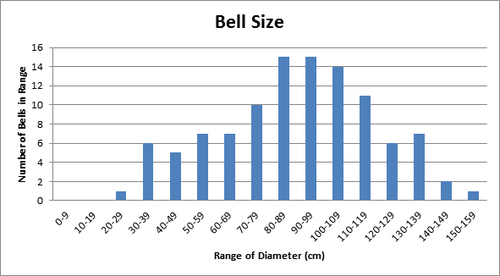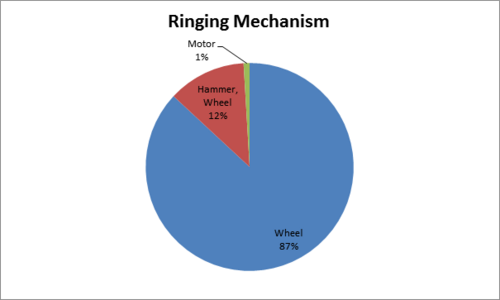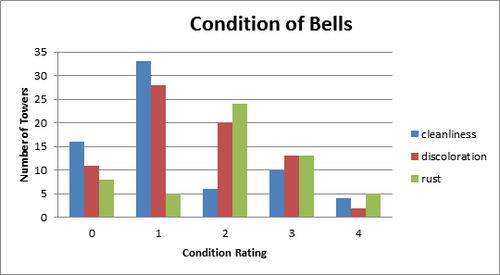Bells
This page is an overview of all the bells in Venice. For a typical bell, see Bell.
This section needs improvement.
Venice has 203 bells spread throughout the city.
History
The beginning of bells dates back to 132 A.D. in China.The idea came from a Chinese philosopher by the name of Chang Heng, who invented the first known earthquake detector.
For more information about bell history, see external_LINK.
Statistics
Venice has 203 bells that have been documented, spread throughout the city. The conclusions made from data collected tell us about the conditions of the bells, what aspects they have in common, and general info such as age, number, and size. By examining the trends for the conditional ratings of bells, it is possible to determine the urgency for renovation. We can also see if this has any relation to the founder or the date of casting of the bells.
Bell Sizes
The largest bell documented is bell 2 of Sant’ Elena with a diameter of 152 cm, and the smallest bell documented is bell 4 of San Nicolò dei Mendicoli with a diameter of 21 cm.

From the graph above, it can be determined that the most frequent size for the diameter of a bell is from 80 to 99 cm.. Ironically, the shape of the graph resembles a bell curve. The average ratio of diameter to internal bell height is 1.22 cm with a standard deviation of .106 cm. Therefore, the size of the bells may vary, but the shape is similar for all bells in the city.
Ringing Methods
The ringing method is the same for most bells in the city of Venice. Hammer and wheel are the primary types of ringing. However, wheel is most common, as 87% of the bells in Venice are rung by wheel. The second most common, are bells rung by both wheel and hammer, which is 12%. The graph below gives an idea of the popularity of these ringing mechanisms for the bells of Venice.

Bell Condition
Because bells are an integral part of the material culture of Venice, it’s important to track the conditions of bells so it is possible to determine when and how much renovation is needed. As discussed in Bell, the materials that they are made from, although durable, are still vulnerable to chipping and cracking, discoloration, and rust. These criteria have been rated on a scale of 0 to 4: 0 meaning there is no need for restoration and 4 meaning that restoration is urgent.

The majority of the bells measured thus far have had a conditional rating of 1 for both cleanliness and discoloration. This means that there is some, but not a problematic amount. Rust had a slightly higher common rating of 2 which still is not very problematic. The ones that need restoration should have rating of 4 for each category. Luckily, there are 5 or less bells for each of the categories that had ratings of a 4. There seems to be little correlation between the three categories. Where there seems to be a great number of bells with a certain rating for one category, there may only be a few rated the same for a different category. Perhaps, when considering a bell for restoration, one may only have to confront one problem. However, from our data we found some bells with a rating of 4 in all categories, such as those in the bell tower of San Silvestro.
See Also
Bell
Bell Ringing
Bell Tower
Bell Towers
NAVIGATION BOX for bells
NAVIGATION BOX for bell towers
References
External Links
- Wikipedia Bell page
- UK Central Council of Church Bell Ringers
- Verdin Bells & Clocks
- AmeriClock Inc., Church Bell Ringing & Bell Strikers